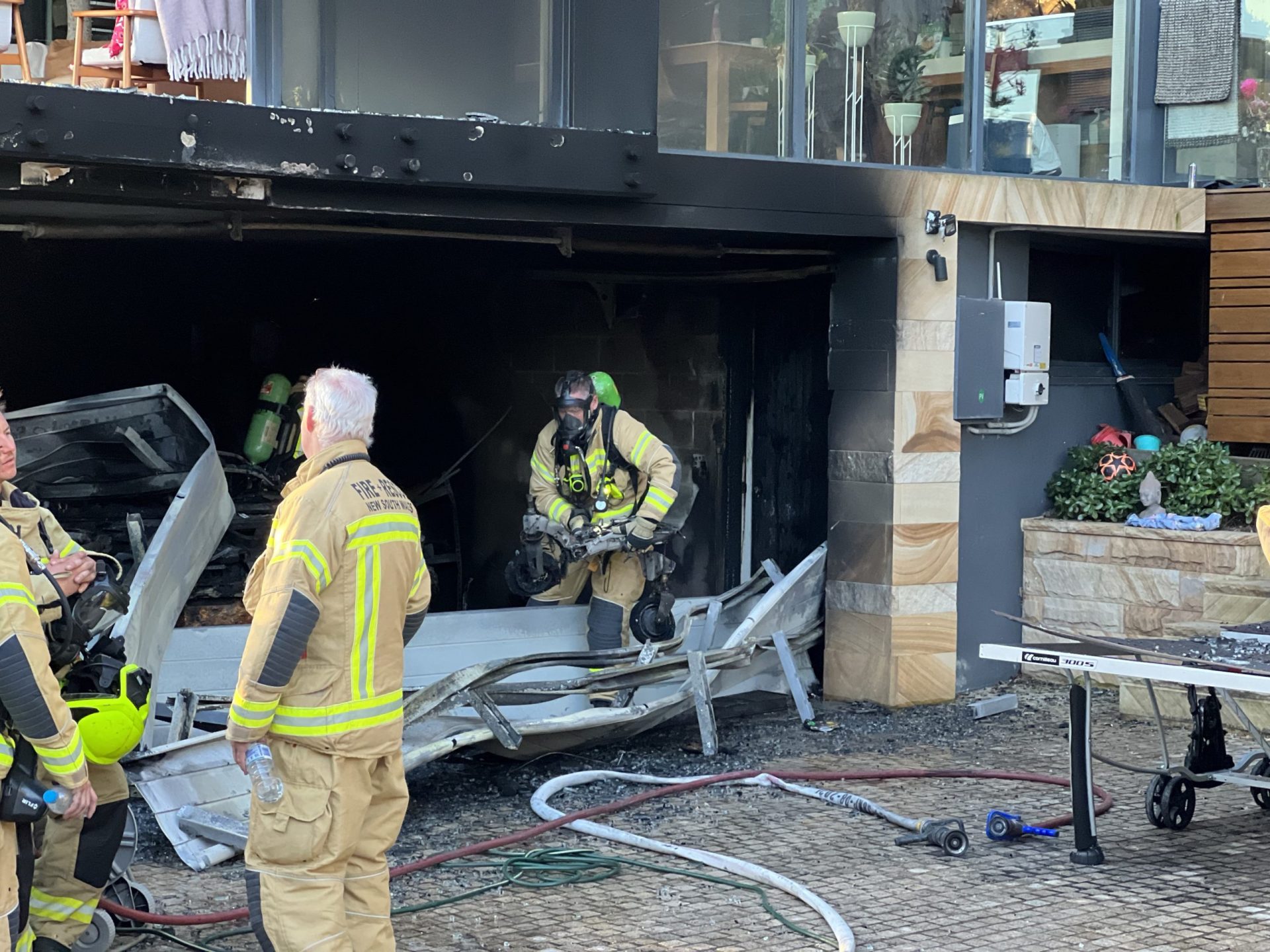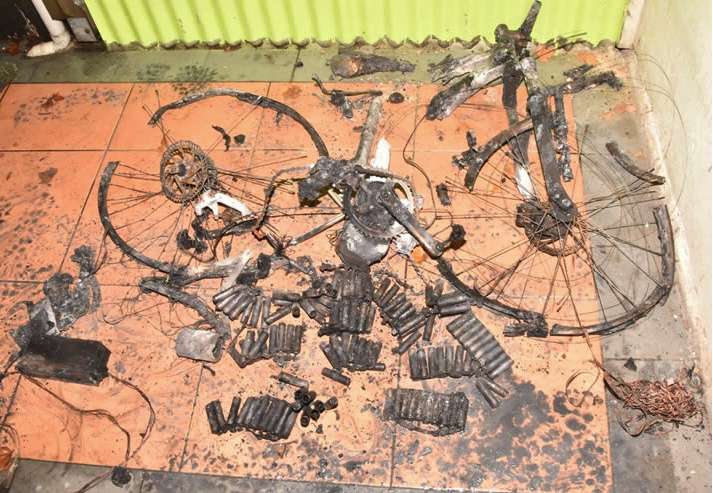Neighbours have rallied around a Narraweena family who have lost all of their belongings, and possibly also their beloved pet, in a housefire this week.
Speaking to one of the home’s occupants yesterday, we understand the fire was caused by an e-scooter that a visiting family member was charging in a bedroom.
The adult resident described hearing a “huge boom” followed by seeing flames around a charging scooter battery, and he ushered his mum and sister out of the property before trying to tackle the quickly escalating blaze.
However, as this was likely a lithium battery fire, it could not be extinguished by water.
The home, number 39 Ronald Avenue, was almost completely destroyed. “We haven’t seen the cat, I think it’s gone for good,” he lamented.
Almost the entire house was incinerated, except his bedroom at the back, he said.
In total four people were evacuated from the home (including the family member who had been charging the battery). Three of the four inhabitants required medical treatment but no injuries were particularly serious.

Neighbours have launched a fundraising campaign. While we understand the home was some form of social housing, the family had lived there for 20 years and almost all of the contents were destroyed or damaged.
“Due to illness she (the mother of two adult children) is only able to work part-time and is very afraid for her uncertain future. They have lived in this home for almost 20 years,” the organiser states. We have not spoken with the organiser.
About the fire
Fire and Rescue NSW (FRNSW) firefighters confirmed they arrived just after 4am Wednesday, 22 May.
A collapsing roof and extreme heat prevented the crews from entering the house, so they adopted a defensive strategy to contain the flames.
FRNSW Duty Commander, Inspector Steven Perkins, said the occupants had an incredibly lucky escape.
“All early indicators are pointing to an e-scooter on charge inside the house as the possible cause,” Inspector Perkins confirmed.
“The nature of Lithium-ion battery fires is extremely volatile.
“When these devices fail, they tend to do so extremely quickly and with great intensity.
“Despite how quickly the fire took hold, our crews successfully prevented it from spreading throughout the entire home to neighbouring properties.”
“As winter approaches, FRNSW is reminding the public to show extra caution around Lithium-ion powered devices such as e-bikes, e-scooters and mobile devices.”
The message comes a year after Fire and Rescue first flagged lithium battery explosions as an escalating issue for their crews.
In April 2023 Superintendent Adam Dewberry confirmed with Manly Observer that the Fire investigation unit was busy piecing together information across the state following repeated incidents with lithium batteries.
Incident data from the first quarter of 2022 indicated that one in one hundred fire calls to Fire and Rescue NSW (FRNSW) involved a battery in thermal runaway, which is an uncontrolled and excessive rise in heat within a battery cell or several battery cells often leading to cell venting and fire.
Among more recent cases locally was an e-scooter lithium battery which caused significant damage in a home at Little Manly in October 2022, an and e-bike fire in Balgowlah April 2023.
 Crews respond to a fire sparked by an e-scooter lithium battery in the garage of a home in Little Manly in October 2022. Photo: Luke Gavahan Media
Crews respond to a fire sparked by an e-scooter lithium battery in the garage of a home in Little Manly in October 2022. Photo: Luke Gavahan Media“We are putting the pieces together because there seem to be a number of factors in these events,” Sup Dewberry said.
There is a general lack of guidance and provisions in building codes, standards, and legislation in relation to safety to address the potential risks from these emerging technologies. Part of the problem is that we do not yet know enough about their probability of failure, their mechanisms of failure and potential consequences of failure.
To better understand these issues and risks, FRNSW is currently leading a collaborative research and testing program largely focused on lithium-ion batteries: the Safety of Alternative and Renewable Energy Technologies (SARET) Research Program due to wrap up around July.
Why the focus on e-bikes/scooters?
The issue has stood out with e-bikes and e-scooters because of the surge in use, particularly by teenagers and delivery riders, Superintendent Dewberry said. However, the safety concerns extend to all lithium-ion batteries which are common also in household power tools. We are aware of reports of fires in garbage trucks because some households have disposed of the batteries in their regular garbage and they have ignited during the trucks crushing process.
On the matter of e-bike battery fires, one of the contributing factors, Superintendent Dewberry added, was the use of lower-quality batteries bought online; ill-equipped batteries being used to modify e-bikes and e-scooters. Often it is also the wrong charger being used to power the battery.
 She’ll be right.
She’ll be right.A photo of a post fire e-bike supplied by FRNSW.
Attention grows on lithium battery safety
Safety campaigns have commenced internationally focusing on safe charging of lithium batteries and risks to avoid. One such campaign is London Fire Brigade’s #ChargeSafe campaign, aimed at informing consumers about the dangers of modifying e-bikes or using non-reputable suppliers. They reported last month that they had been attending an e-bike or e-scooter fire once every two days, a 60% increase on the previous year.
The fire risks arise primarily from poorly regulated or improperly used e-bike conversion kits, batteries and chargers purchased via online marketplaces.
Users are learning how to make modifications – such as putting a more powerful battery in a smaller model bike – via Tiktok and YouTube.
From the firies
We asked Superintendent Dewberry, ‘What are the main things we need to do to know about these lithium batteries?’
“Lithium batteries are great convenience, but they also come at times with a significant risk,” he said. “You can lose your home you can lose your life and there’s a couple of things that you can do to make yourself safer. Make sure that you buy from that reputable retailer and that includes the battery and the charging system as well.
“IF YOU DO HAVE A BATTERY THAT CATCHES ON FIRE, ALWAYS CALL TRIPLE ZERO BECAUSE YOU CAN THINK YOU’VE GOT IT OUT BUT THESE BATTERIES CAN CONTINUE TO HEAT UP AND THEN REIGNITE WITH EXPLOSIVE FORCE CAUSING MORE DAMAGE.
“Where we’re starting to see problems is people modifying batteries to suit the different bike or scooter or using a different charger on the modified battery and that is starting to show to be a cause of fire in and around the homes. A fire in a home can actually develop to take out the whole home in a matter of minutes. In ten minutes you can lose your home, lose your life.
“If you do have a battery that catches on fire, always call triple zero because you can think you’ve got it out butt these batteries can continue to heat up and then reignite with explosive force causing more damage. We don’t want you to pick them up or do anything with them; call the firefighters who have got specialist equipment to monitor and extinguish it and resolve the issue for you… Like I said, they’re a great convenience, because you must treat them with respect.”
In the pipeline
Bicycle NSW CEO Peter McLean said in 2023 it was an issue his organisation was also paying close attention to. The group is considering its own education and awareness campaign, he added.
 NSW Bicycle CEO Peter McLean
NSW Bicycle CEO Peter McLean“There are Australian standards for batteries and battery chargers, so we always advise people to ensure they are buying quality products which are AS certified (For Battery chargers is AS/NZS 60335.2.29). There are strong indications that a number of uncertified products and chargers are being purchased online and in some cases that modifications are being made to rapidly charge batteries and this has caused many of the concerning incidents we read about.”
Recap: how can you stay safe?
Lithium batteries safety tips
When buying, using or charging Lithium-ion products, FRNSW advises the public to:
- Be aware that Lithium-ion batteries are prone to reignite after the initial fire has been extinguished.
- Buy Lithium-Ion products and batteries from reputable suppliers that meet Australian standards.
- Only use cords and chargers supplied with the device. Don’t use inferior or different voltage replacement components.
- Never charge devices while you are sleeping or in places that could block your escape.
- Do not over-charge batteries. Switch off any cells once fully charged to avoid over-heating.
- Try to charge micro-mobility devices like e-bikes and e-scooters outside, away from the home and on a hard surface.
- Charge in a clear non-combustible area near a smoke alarm.
- Note that any strong odours, extreme heat, colour change, deformity or strange sounds could indicate a problem with a Lithium-ion battery.
- Dispose of Lithium-ion batteries properly, don’t throw them out with household garbage.
The public can find further information about Lithium-ion battery safety on the FRNSW website: https://www.fire.nsw.gov.au/batteries



